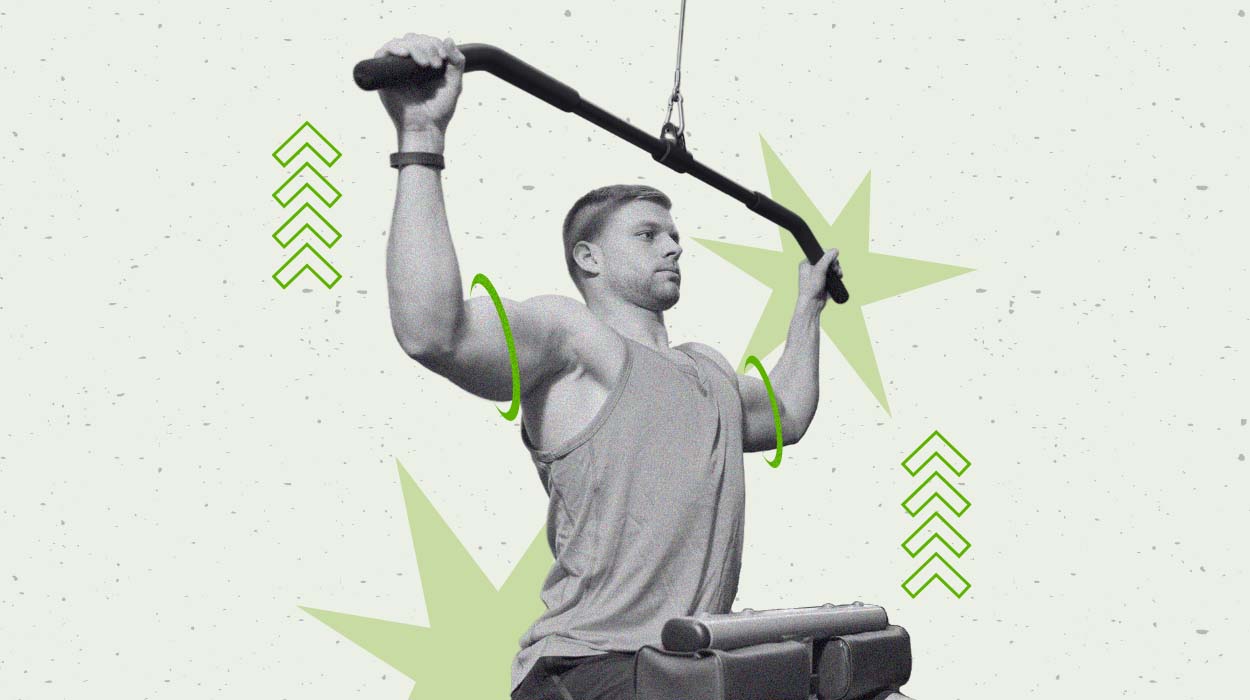
Do you recognize the satisfaction you get when you don your favorite T-shirt and can see the effort you put into building your shoulder and arm muscles? It goes beyond just looking good. Strong shoulders and arms help you stand upright, make daily tasks easier, and protect you from harm.
Furthermore, upper-body resistance training offers certain cardiovascular benefits[1] that are only amplified when combined with aerobic activity.
So, if you’re ready to crank up your workout with a mind-muscle connection, we’ve compiled a list of the top arms and shoulders exercises. Each exercise session helps to burn fat and build upper arm muscles to help you shape and tone your body.
Arm And Shoulder Workout To Try
Doing arm and shoulder workouts at gym locations or at home is a great cardiovascular exercise that you can use to tone and bulk up your upper body strength. Arm and shoulder exercises help build your upper body muscle mass, making you stronger to complete your daily activities without injury or back strain, which can lead to chronic pain and immobility.
Best Arms And Shoulders Workout To Try
If you want to strengthen your back muscles, you must incorporate specific exercises into your routine. Here are the ten best arm and shoulder exercises you can do at your gym:
Bicep Curls
Bicep curls are a fundamental exercise that primarily targets the biceps brachii muscles in the upper arms. Bicep curls are a versatile exercise that can be customized to suit various fitness levels, making them an essential addition to any comprehensive upper body routine.
Bicep curls help sculpt and strengthen the biceps, enhancing the appearance of your arms. Additionally, it contributes to improved arm strength and stability, which can be especially advantageous in everyday activities and sports. Furthermore, bicep curls can indirectly benefit the shoulder joint by improving its stability and muscular support.
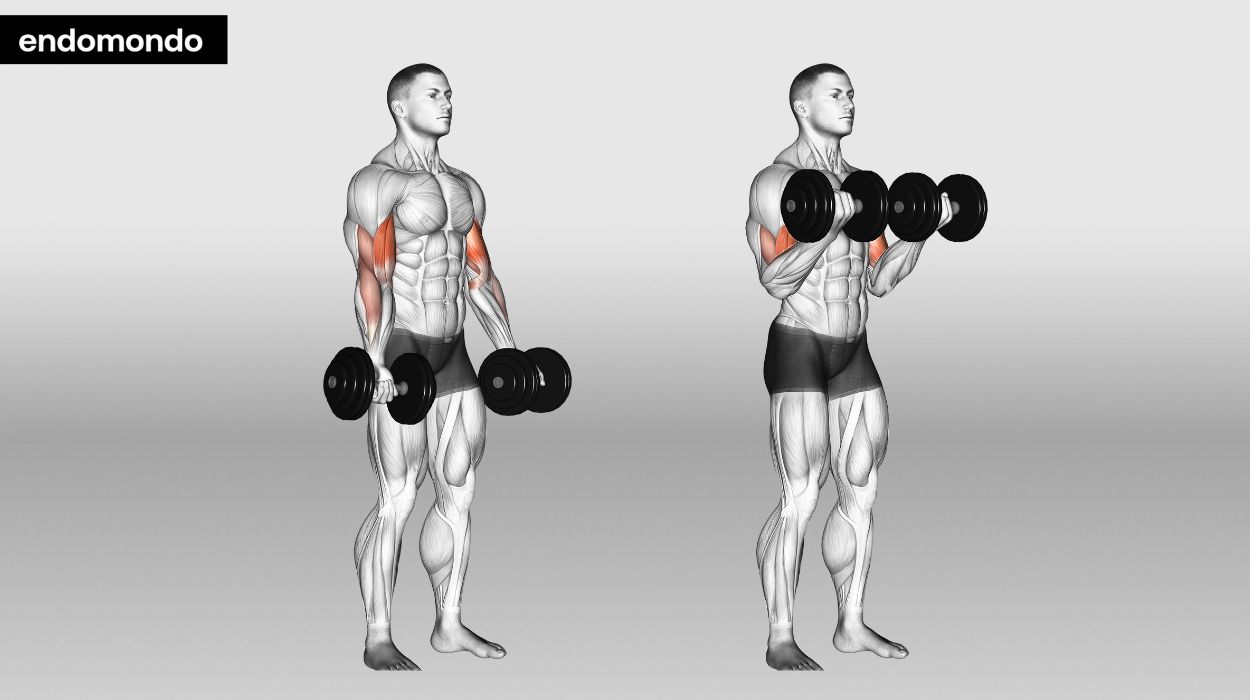
How to do:
- Grab a pair of weight-appropriate dumbbells.
- Hold one in each hand.
- Let them dangle by your sides while rotating your palms to face forward.
- Now, gradually bend your elbows, keeping your wrists straight, raising the dumbbells towards your shoulders. Remember to keep your elbows near your body as you slowly bring the dumbbells back down to the starting position, and do not hunch your shoulders.
Tips:
- Avoid swinging or using momentum; instead, focus on isolating your biceps.
- Lower the weights back down until your arms are fully extended, allowing for a complete stretch of the biceps.
- Maintain steady, controlled breathing throughout the exercise.
Optimal Sets and Reps: 2 sets of 10 reps.
Seated Dumbbell Shoulder Press
The Seated Dumbbell Shoulder Press is an overhead press that requires a bench with a raised back and two medium-weight dumbbells. It primarily works your upper arms and abdominal muscles.
Incorporating the seated dumbbell shoulder press into your routine helps you achieve well-rounded shoulder development, supporting both aesthetic goals and overall upper body strength.
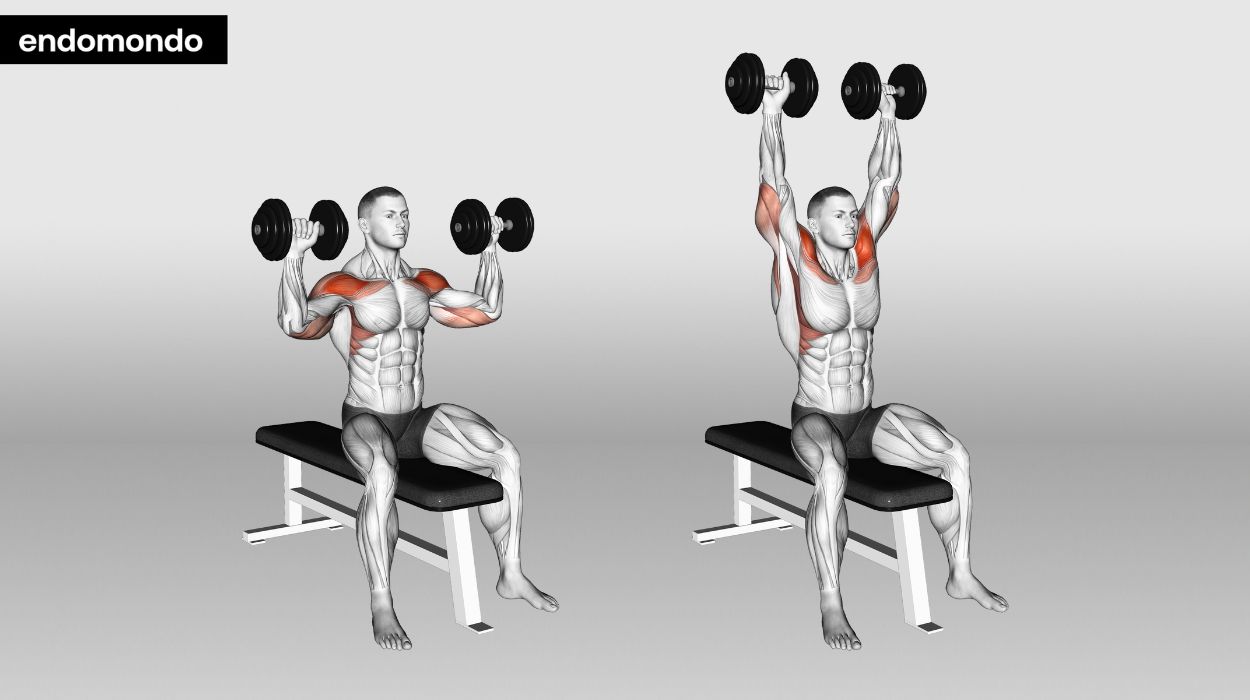
How to do:
- Place your back and shoulder muscles against the elevated backrest of the bench as you sit with your feet hip-width apart and flat on the floor.
- Dumbbells should be placed on your thighs. Choose lighter weights until your strength improves.
- Lift the dumbbells up to your shoulders after that while inhaling deeply. Your starting point is here.
- While exhaling, lift the dumbbells straight up above your head in an overhead press with your core engaged.
- Lower the dumbbells back down to your shoulders in a controlled motion while inhaling deeply.
Tips:
- Keep your back straight, core engaged, and chest up throughout the exercise to maintain proper posture.
- Avoid using momentum or arching your back.
- Choose dumbbells that challenge you but allow you to perform the exercise with good form.
Optimal Sets and Reps: 3 sets of 12 reps.
Reverse Fly
The reverse fly is a highly effective exercise that primarily targets the posterior deltoid muscles, along with the trapezius and rhomboid muscles of the upper back. As a crucial component of any arms and shoulders workout, this exercise focuses on developing the often-neglected rear shoulder muscles, helping to balance overall shoulder strength and posture.
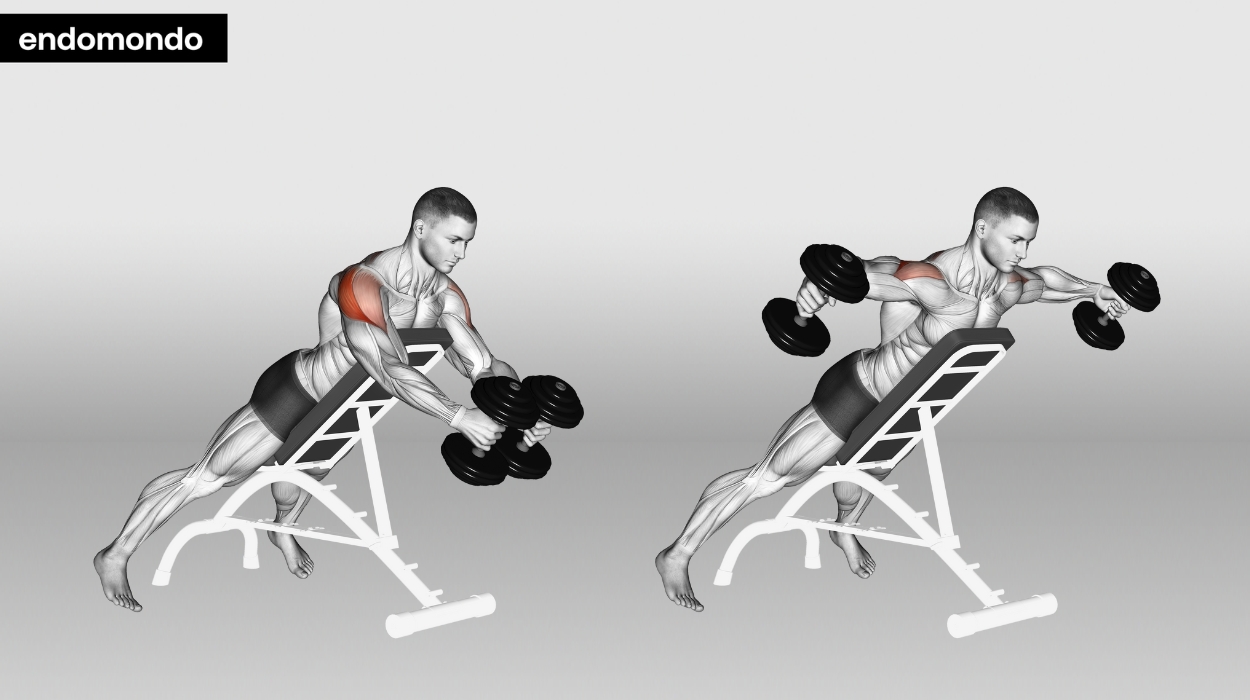
How to do:
- To begin, hold a weight-appropriate dumbbell in each hand.
- Face down on the incline bench until your body is aligned with the ground at a 45-degree angle.
- Raise both dumbbells out to the side, keeping your arms straight but with a slight bend at the elbow.
- As you do this, focus on bringing your shoulder blades together as you pull them inward toward your spine.
- Slowly lower the weights back down afterward to the starting position.
Tips:
- Maintain a neutral spine to prevent strain.
- Ensure you maintain control throughout the exercise, both when lifting and lowering the weights.
- Focus on using your shoulder muscles to lift the weights, rather than relying on momentum.
Optimal Sets and Reps: 4 sets of 12 reps.
Arnold Press
The Arnold Press was created by well-known actor and bodybuilder Arnold Schwarzenegger to maintain his chiseled upper body appearance. It’s an alternative to the standard shoulder press. This exercise can be performed sitting, kneeling, or standing.
By engaging the anterior, lateral, and posterior deltoid heads, the Arnold Press helps sculpt and strengthen the entire shoulder complex. Its unique motion enhances shoulder mobility and flexibility while promoting balanced shoulder development. The exercise also engages the trapezius and triceps, adding to its effectiveness as a full-arm workout.
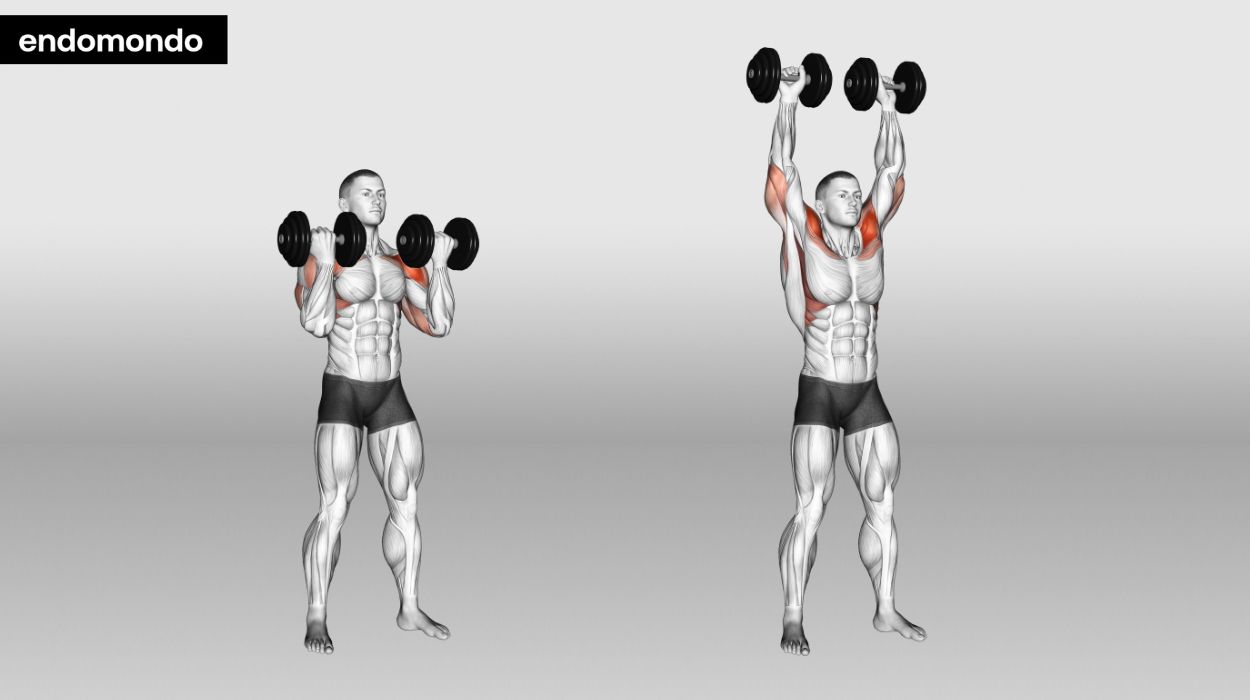
How to do:
- Lift two dumbbells to your shoulder height level.
- Now keep your arms bent and your palms facing you as if you’re performing a bicep curl.
- Press the dumbbells up above your head after that.
- Turn your hands so that the palms are facing forward.
- Rotate your hands back towards yourself as you lower the dumbbells to the starting position.
Tips:
- Be sure not to arch your back and to maintain a straight posture.
- Maintain control and avoid using momentum; instead, focus on engaging your shoulder muscles.
- Ensure a full extension of your arms at the top while keeping your core engaged.
Optimal Sets and Reps: 3 sets of 12 reps.
Chest Press
The chest press primarily targets the pectoral muscles in the chest but also engages the anterior deltoids (front shoulder muscles) and triceps. Besides chest development, this exercise contributes to well-rounded upper body strength, enhancing the aesthetics of your arms and shoulders. Also, it improves upper body stability and functional strength, crucial for daily activities and sports performance.
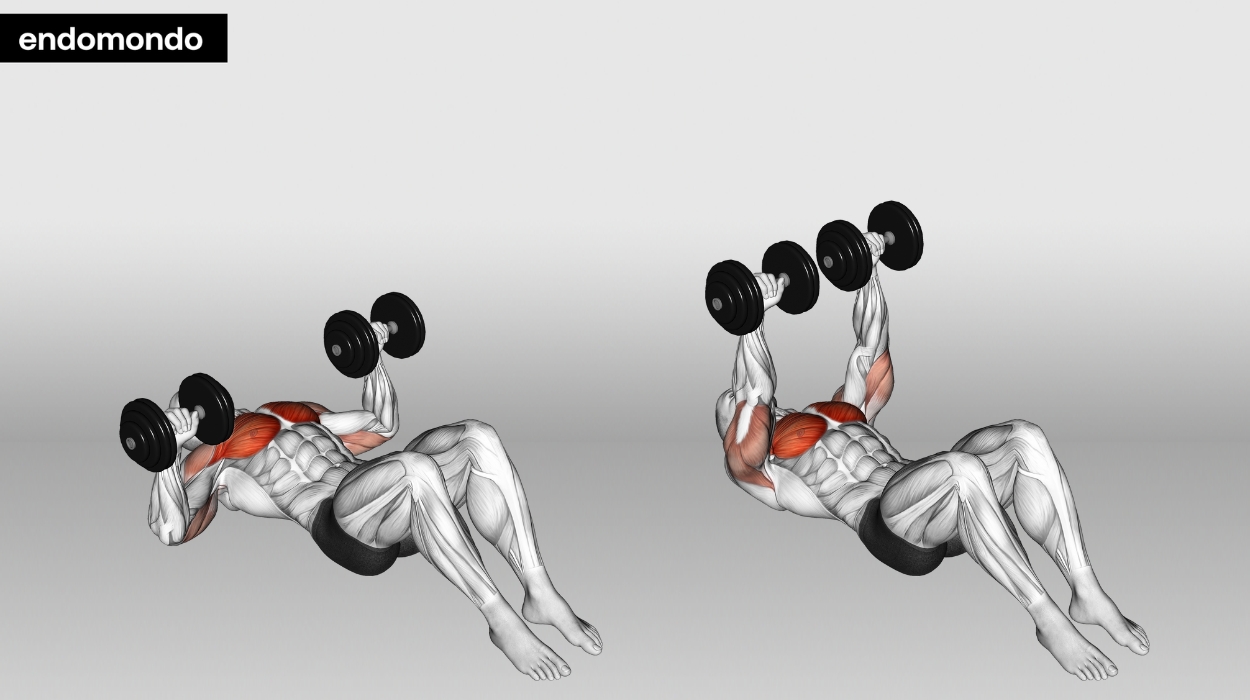
How to do:
- Lie flat on the floor, feet firmly on the floor.
- Hold a dumbbell in each hand above your shoulders, palms facing out.
- Ensure your shoulders are pulled down and your back is flat on the bench.
- Push the weights upward while exhaling, not locking your elbows. Don’t let your head or shoulders come off the bench.
- Now, slowly lower the dumbbells down with muscles contracted while inhaling.
- They should be slightly wider than your chest and elbows somewhat lower than your shoulders. You are back in the starting position.
Tips:
- Avoid bouncing or jerking the weights for a safer and more effective exercise.
- Maintain a stable base by keeping your back, head, and hips in contact with the bench.
- Breathe consistently throughout the exercise to enhance control and maximize your results.
Optimal Sets and Reps: 2 sets of 4 reps.
Rope Hammer Curl
The rope hammer curl is a highly effective exercise that primarily targets the brachialis and brachioradialis muscles in the forearms.
One of the key benefits of the rope hammer curl is its ability to develop forearm strength and thickness, which can enhance grip strength and overall arm aesthetics. It complements traditional bicep exercises, promoting balanced arm development. Moreover, it indirectly benefits the shoulders and upper back by improving grip strength and stability during other upper body exercises.
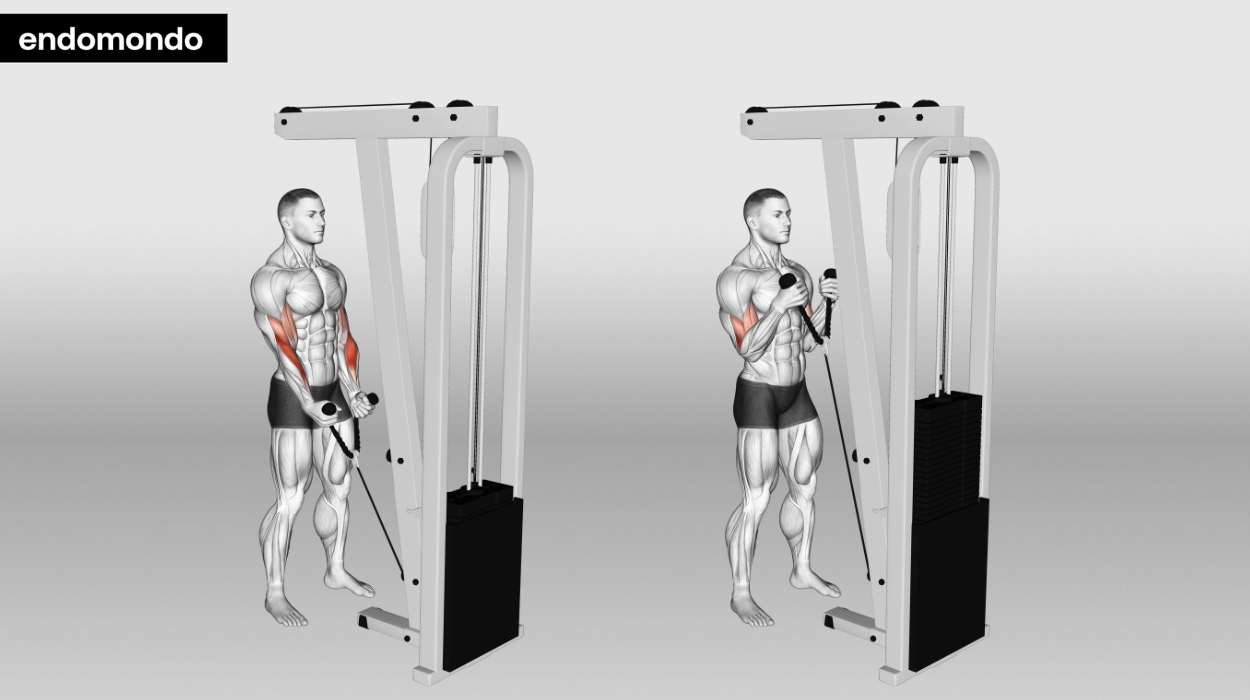
How to do:
- Stand up straight and face a cable machine with a rope attachment low to the ground.
- Hold both ends of the rope in your hands, ensuring your palms face each other.
- Pull the rope towards your shoulders while keeping your elbows close to your body.
- Once the rope reaches your shoulders, gradually allow it to return to its position.
Tips:
- Stand with your feet shoulder-width apart and maintain a straight, upright posture.
- Keep your elbows close to your sides.
- Keep your core engaged to stabilize your body and maintain proper posture throughout the exercise.
Optimal Sets and Reps: 3 sets of 13 reps.
Barbell Lying Triceps Extension
The barbell lying triceps extension, also known as the skull crusher, is a powerful exercise that primarily targets the triceps muscles in the arms. It isolates and strengthens the triceps while also engaging the shoulders and chest muscles to support the movement.
The benefits of the barbell lying triceps extension extend beyond triceps development. It helps improve overall upper body strength, enhance triceps definition, and contribute to a sculpted and balanced upper body appearance.
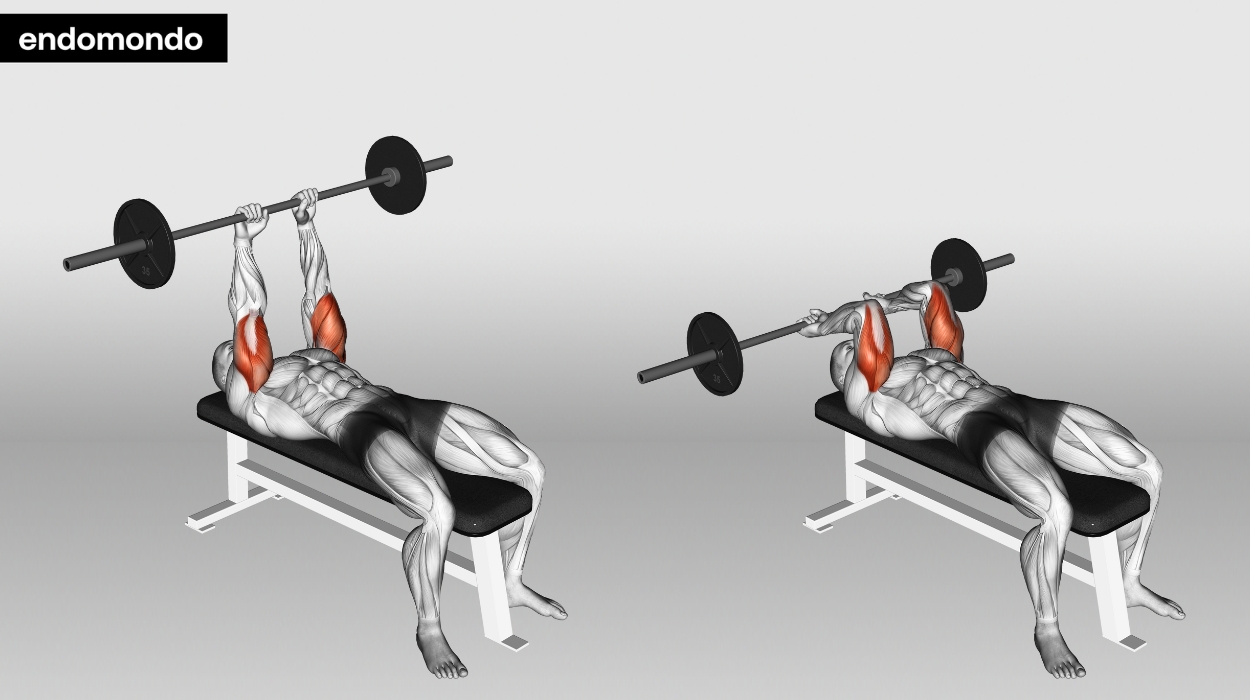
How to do:
- Lie down on a bench, ensuring your feet are on the ground and your head is near the edge of the bench.
- Grab a barbell with your hands. Keep it positioned above your chest, fully extending your arms.
- Slowly lower the barbell behind your head, bending your elbows until it is about an inch from your forehead.
- Pause, raise the barbell over your chest, and fully extend your arms to return to the starting position.
Tips:
- Use a comfortable, secure grip to prevent unnecessary strain on your wrists and forearms.
- Keep your upper arms stationary throughout the movement, and avoid flaring your elbows.
- Engage your core muscles to stabilize your torso and minimize any excessive arching of your back during the exercise.
Optimal Sets and Reps: 4 sets of 10 reps.
Bench Dip
The bench dip is a versatile exercise that primarily targets the triceps muscles. By using your body weight as resistance, it effectively engages the triceps, chest, and front shoulders.
Bench dip enhances upper body strength, promotes improved shoulder stability, and provides a sculpting effect on the arms and shoulders. This exercise can be adjusted to suit various fitness levels and can be done virtually anywhere with a stable surface, offering convenience and versatility.
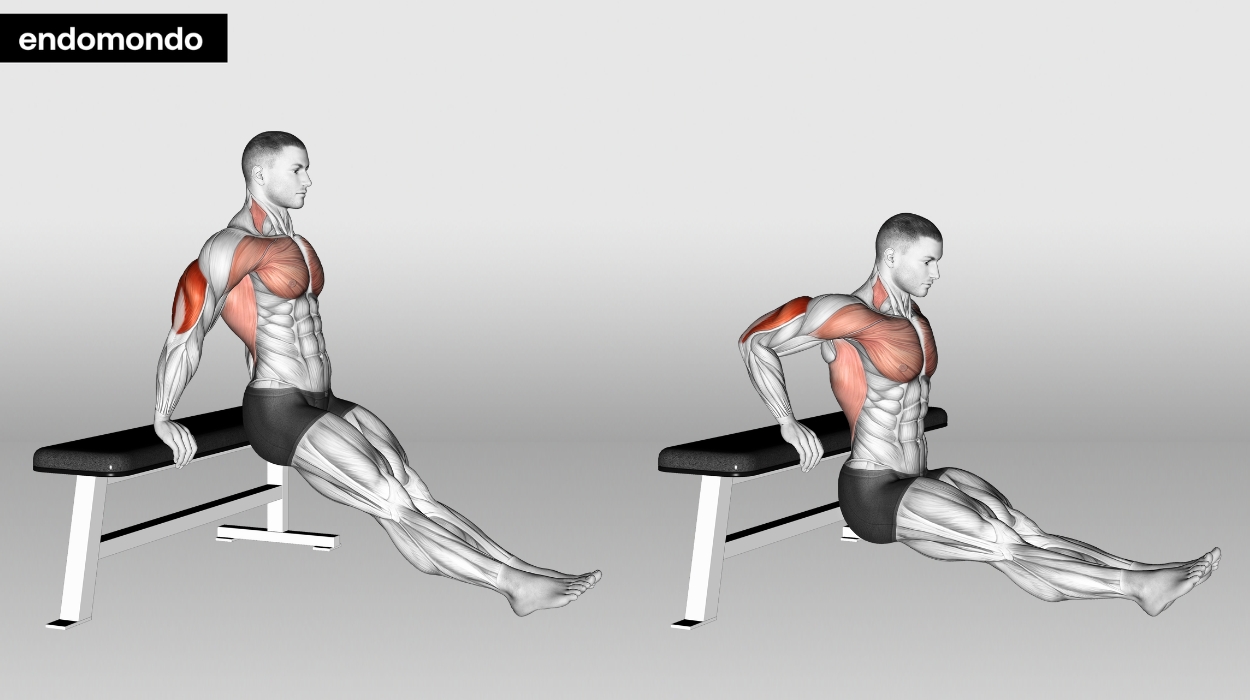
How to do:
- Sit on the edge of a bench.
- Place your hands beside your hips with your fingers resting on the edge.
- Extend your legs forward.
- Rest your toes on the floor.
- Slowly raise your hips off the bench while ensuring that your lower back remains in proximity to it.
- Then gently flex your elbows until they reach a 90-degree angle behind you.
- Lastly, use your hands to push yourself back into the position and fully straighten out your arms.
Tips:
- Keep your shoulders down and away from your ears to prevent unnecessary tension.
- Maintain a stable core by keeping your hips close to the bench throughout the movement.
- Keep your wrists straight to reduce strain and maximize stability.
Optimal Sets and Reps: 4 sets of 10 reps.
Alternating Dumbbell Front Raise
The alternating dumbbell front raise is a fundamental exercise for strengthening the anterior deltoid muscles in the shoulders, making it a crucial component of any arms and shoulders workout. Raising one dumbbell at a time helps isolate and target the front shoulder muscles effectively.
This exercise not only helps with shoulder development but also enhances shoulder stability, promoting better posture and reducing the risk of injury. Moreover, it contributes to improved overall upper-body strength and complements other shoulder and arm exercises.
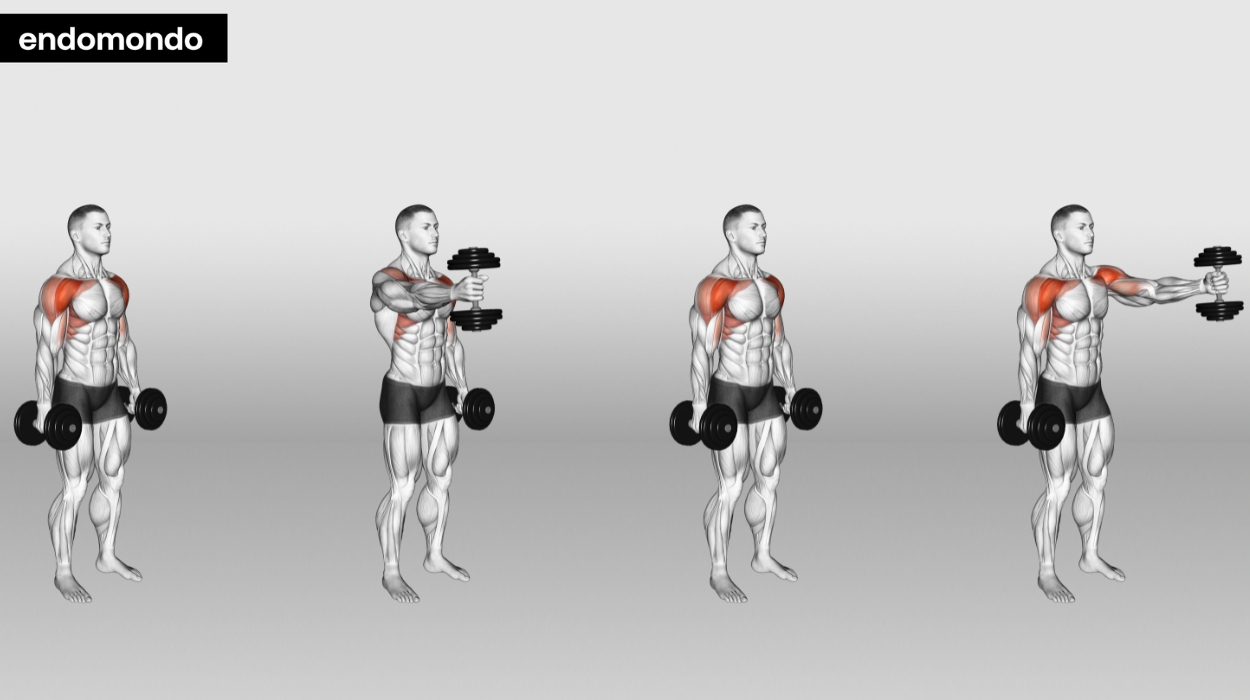
How to do:
- Stand with knees slightly bent and a weight-appropriate dumbbell in each hand resting on your thighs.
- Now lift one of your arms up to the height of your shoulder until it is parallel to the floor while exhaling and keeping your elbow slightly bent.
- Gently lower your arm down to the starting position.
- Next, it’s time for your other arm. Lift it up just like you did with the previous arm.
Tips:
- Choose a weight that allows you to perform the exercise with proper control and technique.
- Avoid using momentum or swinging your torso to lift the dumbbells.
- Maintain a slight bend in your elbow joints to protect them from unnecessary stress.
Optimal Sets and Reps: 4 sets of 10 reps on each side.
Concentration Curl
The concentration curl is a targeted exercise designed to isolate and strengthen the biceps brachii muscles, creating a pronounced peak and definition.
This exercise offers several benefits. It helps in sculpting well-defined biceps, enhancing the aesthetics of your arms. What’s more, it promotes enhanced arm strength and stability, which can be beneficial for various daily activities and sports.
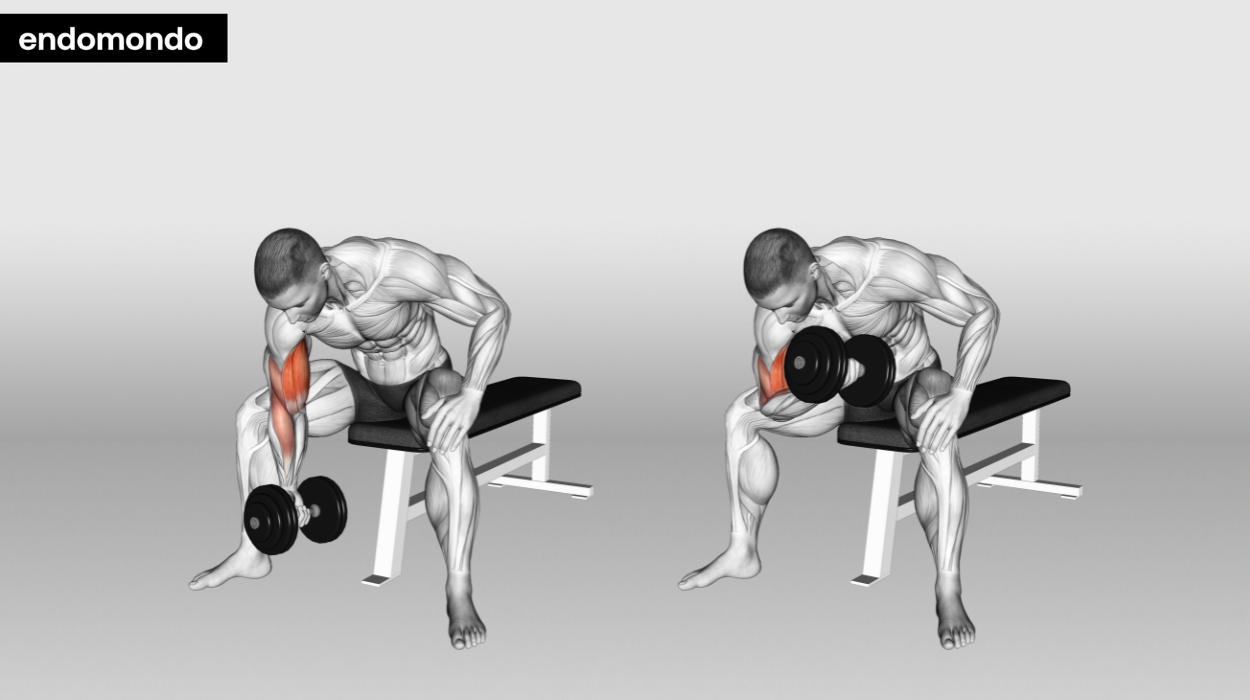
How to do:
- Sit on a chair or bench. Make sure your feet are firmly planted on the ground.
- Take hold of a dumbbell in your left hand with your palm facing up.
- Lean forward. Rest your elbow on the inner side of your thigh just above the knee. To maintain stability, place your right hand on the knee of your leg.
- Using your elbow as a pivot point, raise the dumbbell towards your shoulder while keeping both your body and elbow still.
- Hold this position for a second while flexing your biceps.
- Then, slowly lower the dumbbell back to its starting position.
- Once you have completed this movement with your left arm, switch to the right arm and repeat the same process.
Tips:
- Focus on isolating your biceps and using your arm’s strength for the movement.
- Lower the dumbbell all the way down to full extension on each repetition.
- Maintain control throughout the exercise, both when lifting and lowering the weight.
Optimal Sets and Reps: 3 sets of 10 reps per side.
Why You Should Train Your Arms And Shoulders?
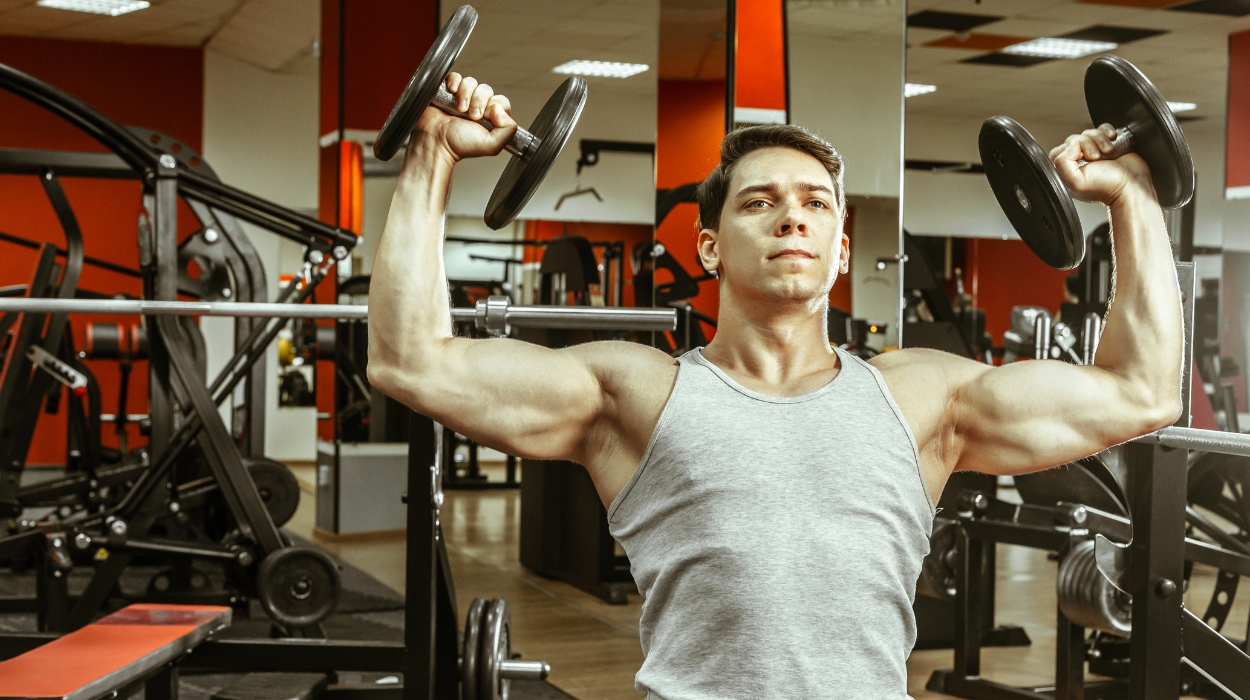
It’s not just for aesthetic reasons that you should train your shoulders and arms.
Firstly, it helps improve your posture. Something interesting occurs when you tone your back muscles. Your shoulders naturally pull back, giving you an upright posture.
And your core benefits as well. Stronger muscles in this area ensure that your body maintains an upright position without slumping, which improves your overall postural alignment and stability.
Training your arm and shoulder muscles also boosts your metabolism. This metabolic boost simply means that you burn calories even at rest.
Combining aerobic and anaerobic resistance[2] exercises improves athletic performance in many sport-related activities.
Anatomy Of Shoulders And Arms
The shoulders and arms combined coordination are capable of numerous movement patterns required to perform various daily tasks. Their structures consist of muscles, tendons, and ligaments connected to the bones of the arms, ribs, shoulder blades, and collar bones. The muscles that make up the shoulders and arms provide both primary and supportive actions.
It is beneficial to understand shoulder and arm anatomy especially when considering your workouts.
Shoulder Muscles
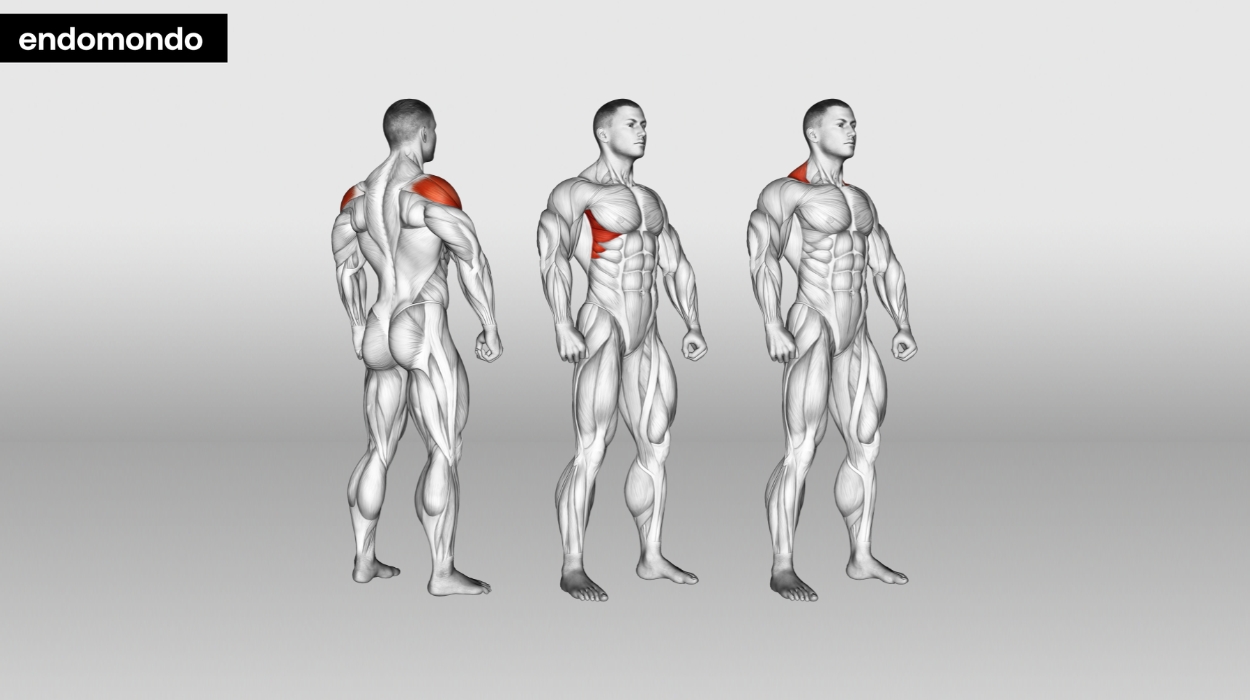
Your shoulder muscles, tendons, and ligaments[3] attach your arms to your body. Several muscles originate on the shoulder blade or scapula as well as the humerus or upper arm bone. The rotator cuff is a group of four muscles that provide stabilization for arm-reaching, lifting, and pressing activities.
Other muscles that act to move and support the shoulder are the deltoids, serratus anterior, and rhomboids. The levator scapulae and trapezius attach to the upper spine so they assist neck movement in addition to the shoulder and arm. Muscles that move the shoulder and arm must act in a balanced rhythm for proper exercise execution and performance of daily tasks.
Arm Muscles
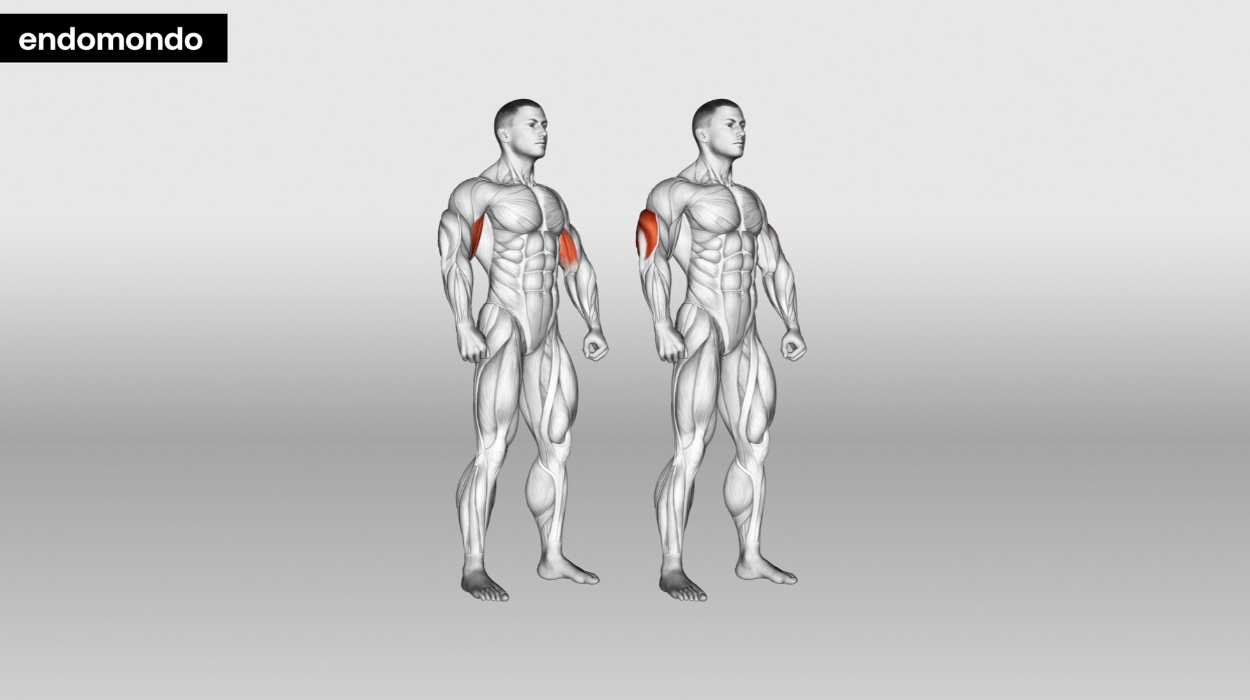
Arm muscles are the biceps and triceps. They are the primary elbow movers, but the bicep also helps raise the arm forward. These muscles assist in lifting, pressing, pulling, and pushing.
Biceps and triceps are most often trained on arm day but other essential arm muscles should not be ignored. However, another muscle that moves and attaches to the upper arm also provides back support, the latissimus dorsi. The pectoralis major is considered a chest muscle but links the arm to the torso and aids the arm with forward lifting.
The muscles below the elbow assist in turning the forearm and moving the wrist. The wrist, elbow, and shoulder muscles must be considered for well-balanced workouts.
Workout Safety Tips
The primary focus of any workout program should be safety. Here are some tips to ensure you engage your shoulders and arms workout safely and avoid injury:
Warm-Ups Are Important
It’s crucial to warm up before your workout. It gets your body ready for the upcoming, more challenging activities. Try to do some light exercises for five to ten minutes. A simple exercise like walking is great for warming up. It gets your body moving without putting too much strain on it.
Prioritize Form Over Lifting Heavier Weights
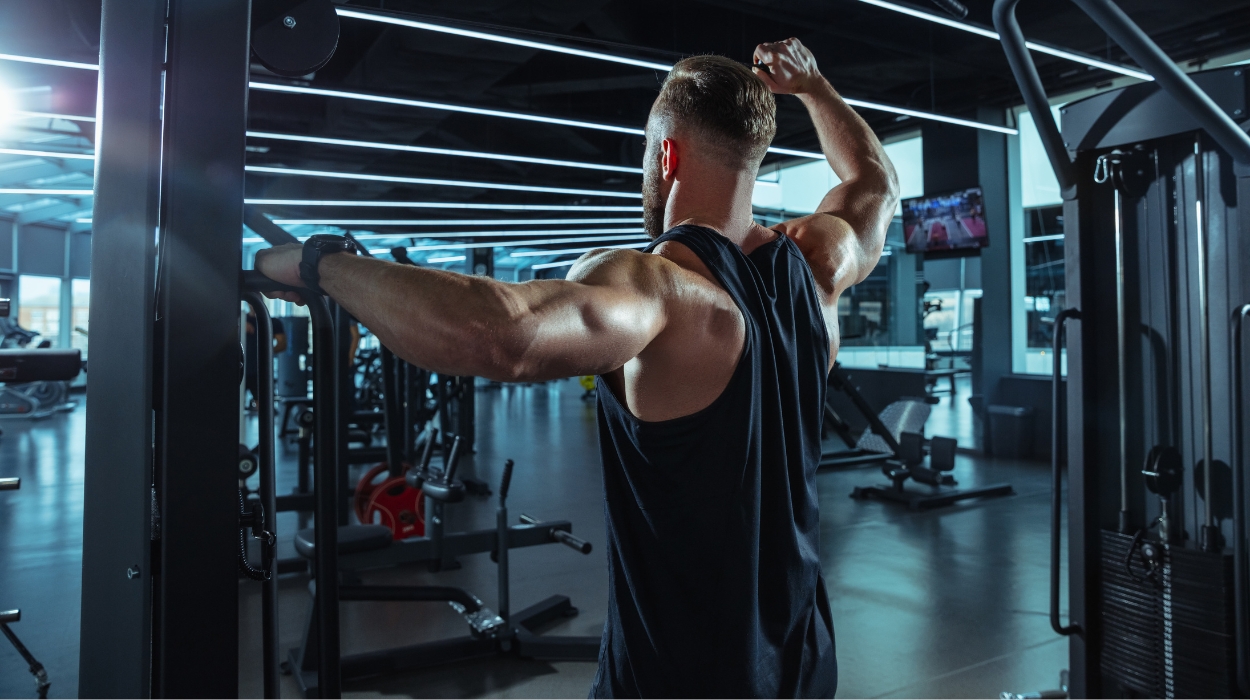
Getting your body positioned correctly and moving smoothly during your exercises is important. This is especially true when it comes to chest press exercises. Before diving into weights, it is advisable to begin with no weights or a lighter weight. This approach will allow you to focus on mastering the exercise technique.
Gradually Add More Weight
You need to gradually add more weight to your workout to strengthen your muscles. The weight you choose should make the last two reps challenging. But remember that the proper execution of the exercises is more important than the weights you lift. Even if you’re lifting heavier weights, make sure you’re doing the exercises correctly to avoid injury.
Stay Consistent With Your Routine
Depending on your training plan, you can set different days for training your arms and chest. You must make this plan with your trainer and then stick to it. A usual workout plan is to train your arms and chest twice weekly.
Final Thoughts
You need adequate training and discipline to build stronger arms and shoulders. Remember to warm up, maintain proper form, gradually increase the weights, and stick to your routine to get the best results.
Frequently Asked Questions
Including arm and shoulder exercises in your workout plan is an excellent idea. With this method, you can simultaneously target the biceps, triceps, and shoulder muscles.
Your degree of fitness, goals, and workout extent all play a role in the answer. Studies have shown that two weekly sessions[4] bring more hypertrophic gains than one.
Training your biceps on a daily basis is usually not advisable because your muscles need time to rest and heal.
Working out every day can be good for you[5] if you alternate the exercises. Mix hard workouts, strength exercises, stretching exercises, and light cardio throughout the week. This will allow your body to recover between strenuous workouts.
Resources
- Schroeder, E., Franke, W.D., Sharp, R.L. and Lee, D. (2019). Comparative effectiveness of aerobic, resistance, and combined training on cardiovascular disease risk factors: A randomized controlled trial. PLOS ONE, [online] 14(1), pp.e0210292–e0210292. doi:https://doi.org/10.1371/journal.pone.0210292.
- Gillen, Z.M., Wyatt, F.B., Winchester, J.B., Smith, D.A. and Ghetia, V. (2016). The Relationship Between Aerobic and Anaerobic Performance in Recreational Runners. International journal of exercise science, [online] 9(5), pp.625–634. Available at: https://www.ncbi.nlm.nih.gov/pmc/articles/PMC5154721/#:~:text=Research%20has%20indicated%20that%20combined,between%20aerobic%20and%20anaerobic%20performance.
- Miniato, M.A., Anand, P. and Varacallo, M. (2023). Anatomy, Shoulder and Upper Limb, Shoulder. [online] Nih.gov. Available at: https://www.ncbi.nlm.nih.gov/books/NBK536933/.
- Schöenfeld, B.J., Ogborn, D. and Krieger, J. (2016). Effects of Resistance Training Frequency on Measures of Muscle Hypertrophy: A Systematic Review and Meta-Analysis. Sports Medicine, [online] 46(11), pp.1689–1697. doi:https://doi.org/10.1007/s40279-016-0543-8.
- Chen, M.-H., Yu, C.-L. and Chang, S.-H. (2020). Constant Daily Exercise to Keep the Doctor Away: A Study of Adherence to Physical Exercise Using a Gym in Individuals Older Than 55 Years. International Journal of Qualitative Studies on Health and Well-being, [online] 16(1). doi:https://doi.org/10.1080/17482631.2020.1859174.




